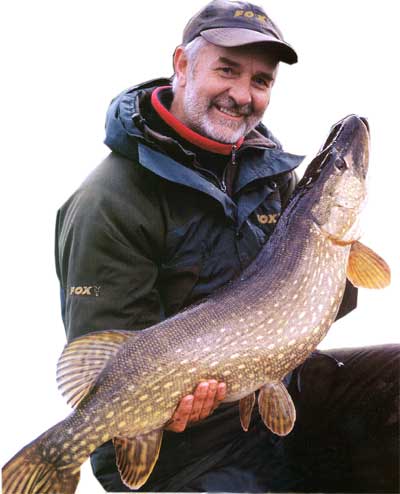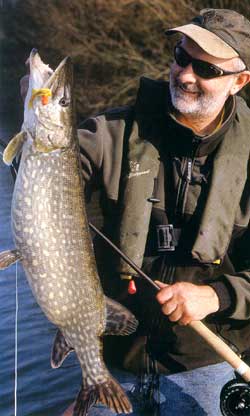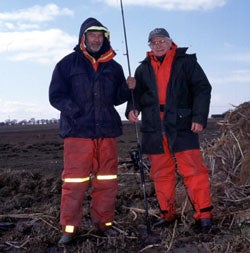Journalist and predator angler Chris Bishop fell in love with the Fens when he moved to Norfolk five years ago. In a new monthly series, exclusive to FISHINGmagic, he gives us a glimpse of this unique landscape and some of the characters who fish it.
MICK BROWN Mick Brown’s passion for predator fishing burns like the twinkle in his eye. It’s what brought him to the Fens around 30 years ago and what still fires him up with the same enthusiasm today. The love affair began when he joined the South Staffordshire Specimen Group in the early 1970s. “All of a sudden I started spreading my wings a bit,” he said. “I started reading about the Hampshire Avon, the Fens and the Broads. I used to read about this great sluice in the Fens and imagined a great big waterfall.” Denver Sluice, which regulates water levels throughout the Great Ouse system didn’t turn out to be quite as picturesque when he got to make the pilgrimage.
“When I said you’re Neville Fickling aren’t you, he just said “yeah..?”. He was very guarded, he used to refer to us as the ‘Orrible Midlanders.” ‘Orrible or not the likes of Mick Brown, Phil Smith, Merv Wilkinson, Andy Barker and Ray Brown were drawn to the Fens like a magnet, hitting the area just as its pike fishing went into overdrive. “They had some famous catches, there were lads from the Midlands and lads from the north-west like John Watson, Malcolm Bannister, Gord Burton and his brother. “We all became quite friendly, we used to arrange our trips so we could all meet up together.” People still talk about the early 70s today, when a string of big fish, topped by Dave Malin’s 33 from the Delph, came out of the drains. It only lasted a couple of seasons; when modern-day Fenland pikers find sport like it they tend to keep it close to their chests. Fenland has been eclipsed since then, firstly by the Broads, secondly by new opportunities in the shape of trout waters.
“We realised there’s a different world out there and the way we see pike fishing living in a big city is different to the way guys see it living in the Fens,” said Mick. “When we read they’d caught 49 over 20lbs it blew our minds – we never thought in a lifetime we could catch 49 over 20lbs, although, after I discovered the devastating effect of pre-baiting a few seasons ago, I caught 29 over 20lbs in just one season.” The late Ray Webb’s lifestyle certainly was out of a different world, as Mick and his mates discovered when they took up an invite to drop by his caravan parked on the banks of the Old Bedford. “He’d got a washing line in there with his underpants and vests hanging up,” he said. “There were cabbage leaves pegged up between them and there wasn’t much difference in colour between them.” Ray Webb’s tackle and bait were another eye-opener to say the least. “He had these kids’ six foot fibreglass rods, bungs made out of chunks of polystyrene and his baits were just heads and skeletons. We thought he was potty at the time, but he told us a lot about his theories about how to catch big pike.
Enter the zander While pike fishing declined towards the end of the 70s a new challenge was just around the corner in the shape of the zander stocked into the Relief Channel. “In 1979, when they entered the Middle level around Three Holes, we started to get some phenomenal catches. We had several 100lb catches of zander but they seemed to top out at 9lbs. There were rumours of the odd fish in the lower Middle Level so I decided to go for a week’s holiday and caught six fish including one of 13:03.” While they targeted all the drains, the travellers got to grips with the Old Bedford, between Welney and Salter’s Lode. “We very quickly worked out that anywhere the water was coloured, you caught zander and anywhere it was clear you caught pike,” said Mick. “By the sluices you’d always have 500 yards of muddy water and that’s where the zander would be.” Zander fishing in the late 70s and early 80s was very different to the all-night vigils favoured by many of today’s predator anglers. “We used to drive across for one day’s fishing, we rarely night fished and we never used to put up a bivvy,” said Mick. “We were very mobile, always float fishing and we’d cover the best part of a mile during a day’s fishing – after doing that you didn’t feel like staying out all night.” A career change and a birthday present The change came in the mid-80s, when Mick decided on a career change and punched out of the plastics factory where he worked for the last time.
“I was meant to be a planning engineer but what my boss didn’t realise was I spent most of my time planning how I was going to leave the company.” He took redundancy so he could spend more time fishing, doing odd jobs and car repairs in his spare time. “In the middle of a building job in October I went fishing in the Fens for four days and came home the day before my birthday,” he said. “My wife asked me what I wanted for my birthday and I said I couldn’t think of anything. She said go on, there must be something you want, so I said: ‘Okay, I want to go back to the Delph and have another session. “She packed the car with food and stuff and off I went.” Mick’s birthday present was an 11lb zander – photographed on the bank with his birthday cards beside him. Then a job came up at the Hotpoint factory, in Peterborough. Mick got it and decided to move to Market Deeping, in South Lincolnshire, after he got his map out to check where the most water was. “Within a five mile radius there were 80 pits, drains and rivers – I thought, ‘that’s the place for me.’ It was like a dream for someone like me living in a city. Just jump in the car, drive 10 minutes and I could be catching pike.” The dream turned into a nightmare Barely a year later, in 1988 the dream came to an abrupt end in the worst way imaginable when Mick’s wife Stephanie developed a brain tumour and died. Fishing took a back seat, not surprisingly. So did work. Mick packed up his job so he could look after his two young children Daniel and Nicola.
“I could only fish from 9am to 2.30pm, so I had four hours to fish if I went anywhere. I did a study of all my local pits, worked out which were worth piking and tracked down some very big fish.” The water concerned was still run by the gravel company and fishing wasn’t technically allowed. To begin with, the foreman turned a blind eye to the odd angler. But when litter and discarded tackle began to appear, they were turfed off. Mick still had those big pike in his sights and adopted a stealthy approach. In one incredible week he landed four over 30lbs, a feat unequalled to this day. His articles began to bring in a useful income and he formed his business Mick Brown Angling Services in 1991. The complete pike fisherman A book Pike Fishing – The Practice and The Passion followed. So did sponsorship from Bruce & Walker, requests for videos and TV work followed and today Mick is a consultant responsible for Fox’s range of predator rods and tackle. “I can honestly say that every time I go out with a rod in my hand I’ve still got that same enthusiasm I’ve always had,” he said. “I can’t wait to get to the water and cast in.” Mick hasn’t been quite as keen to cash in, turning down lucrative offers of TV work and even his own series when it didn’t feel quite right. “I set out to become a complete pike fisherman, able to fish any water with any tactic,” he said. “I’ve spent the last two months fly fishing because I want to perfect my technique. It’s a nice feeling when you feel confident with it, I can’t think of any water I’m afraid of tackling.”
“It opens your mind to techniques, seeing how pike are fished for around the world and finding pike in situations you’d never find them in in this country. “But having done all the travel, I’ve never lost my love of fishing the Fen drains and if there was nothing else I could quite happily stay fishing the Fens. I’d struggle to give you a reason why I like them, maybe it’s because they’re always productive and you can always catch fish. “They’re not at all picturesque but when you’re focussed on something like fishing you don’t notice what’s around you.” When Mick returned to zander fishing in the late 1990s, he brought one tactic he’d learned abroad to the Fens.
Shortly after he began working a lure through the swim, Mick caught one. Nowadays 90 per cent of his zander fishing is with lures like jigs, spinnerbaits and diving plugs. Whatever methods come along in the future, the chances are Mick will be out road testing them somewhere in the flatlands. “There’s a great future, there’s always going to be good fishing in the Fens,” he added. “Maybe it’s just one of those nostalgia things, because I started seriously in the Fens and that’s what keeps drawing me back.” |

















